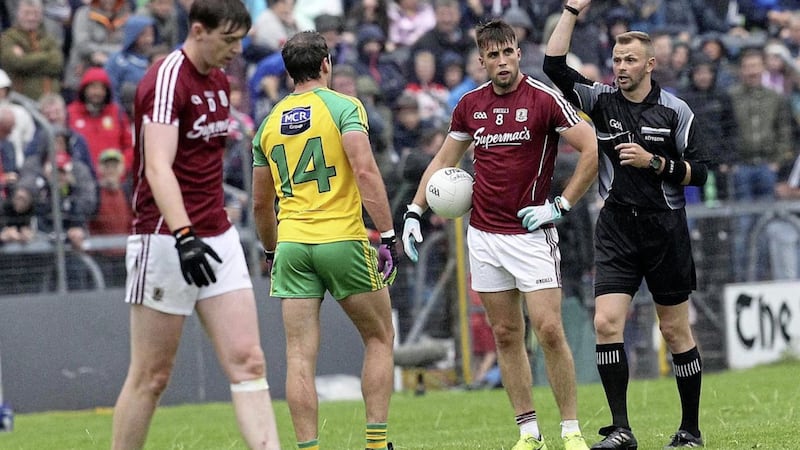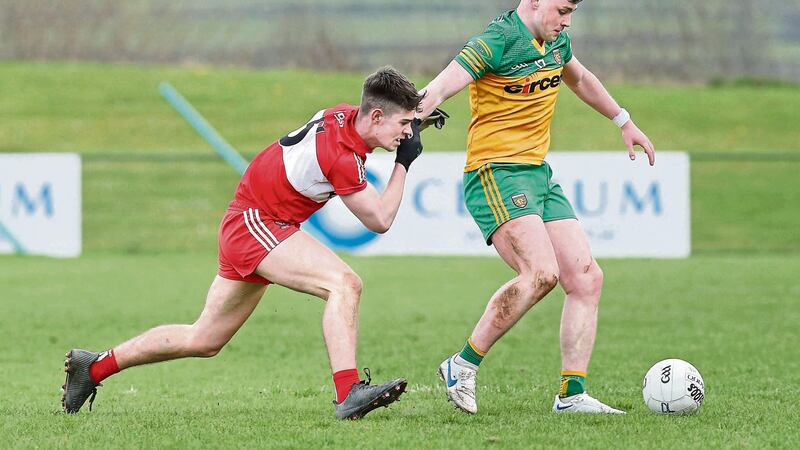THE black card has made a positive difference to Gaelic football in more than one sense.
By removing the bodycheck from the game, it has allowed pace to flourish without fear of being chopped to bits on the run.
Before its introduction, defenders were willingly lining up a man that’s just popped the ball off and leaving every pound of flesh they could writhing on the ground.
We saw examples of it in both codes at the weekend. The worst was Wexford corner-back James Breen leaving everything he had into Austin Gleeson’s chest as the hurler of the year laid off a pass.
Referee Fergal Horgan had no option of a black card and so he did what every football referee did before its introduction and used the best means at his hand, the yellow card.
Those kinds of challenges merit the end of the offender’s game because they were deliberate and premeditated. Yet no referee was ever going to show red because it was borderline, and they will always err on the side of caution.
Players knew it and played on it.
It paid to take a man out – potentially for the rest of the game – knowing a yellow card was the worst you would face.
It was unsightly. It was not conducive to an attacking spectacle. But mostly, it was downright dangerous.
You’re running full tilt and some 14 stone man steps across your open body with his shoulder turned in and his body set like granite, you’re going to feel it.
If the black card goes, those bodychecks would return and that would be a step backwards.
For that reason, it has to be retained in some form.
Those that operate in the mind space where the narrative is that the physicality has gone out of football need to a take a look at the actual reasons for that rather than condoning such cowardice.
That side of the black card is fine. Great, in fact.
But the rest of it has to go.
We’re four years into the experiment and it is still a weekly talking point. The strife over the abolition of rule 21 was gone in half the time.
The real problem for those upholding the law is that, ironically, referees are applying it properly in the vast majority of instances.
There have been moments where referees have failed to show black cards when they should have, not least for John Small in last year’s All-Ireland final.
And there are moments when men have got black cards they shouldn’t have, such as Michael Murphy at the weekend just past.
That will always be the case with any form of punishment. Referees are human. They will get things wrong.
More often than not, though, they are getting it right by the letter of the law.
Kieran McGeary might have been using Gerard McGovern to break his fall in the Ulster final, but he pulled him down. By the letter of the law, it was a black card.
Back to last year’s final and Cathal McShane getting the line for a foul in the Donegal goalmouth. He grabbed the leg.
Croke Park was in a state of disbelief when Dean Rock was black-carded against Kildare but he had pulled at Mick O’Grady’s ankle and pulled him to ground.
They were black card offences as the rules are written, but utterly harmless fouls in the context of any game. Players protest not for their innocence, but for leniency.
None of those instances merited the end of a player’s game. Not even close.
Not one of them happened inside the attacking 45. None of them prevented a scoring opportunity, let alone a goalscoring one.
In the vast majority of cases, the punishment simply does not fit the crime. It’s like getting the electric chair for stealing a loaf.
And it is putting referees under huge pressure all the time over relatively meaningless stuff.
The rules have to be the same at one end of the field as the other because in Gaelic football, you can’t have a rule that punishes obstructing scoring chances more than other fouls.
The scoring area is too big. That would brand any foul inside the 45 as cynical and all that complaining about the lack of physicality would turn from white noise into an inescapable high-pitched squeal.
The true long-term answer to cynicism is, and always has been, staring us in the face.
And the black card’s studious application has heartened me.
Referees were given a set of five specific incidents and told to rigidly implement a specific punishment, and barring the sledging (which is hard to pick up on in most cases), that’s what they have done.
Look at how their instincts have been retrained. All the other fouls go on as normal but someone pulls a leg like Dean Rock did and instantly the switch goes in their mind.
You can tell instantly from a ref’s demeanour. They straighten up. The shrill of the whistler is louder. The book is flipped out and the march across is gilded with intent.
Given clear instruction on what to do in certain instances, officials have zoned in on them and applied the laws rigidly.
That makes me hopeful that they might be able to take on board equally specific instructions over the yellow card.
Take the same number of fouls, designate them as clear yellow card offences. You introduce a one-match ban for picking up three yellow cards in a season, with an amnesty at All-Ireland quarter-final time.
Then sit back and watch how the game rids itself of cynicism in a much more even-handed and consistent manner.








